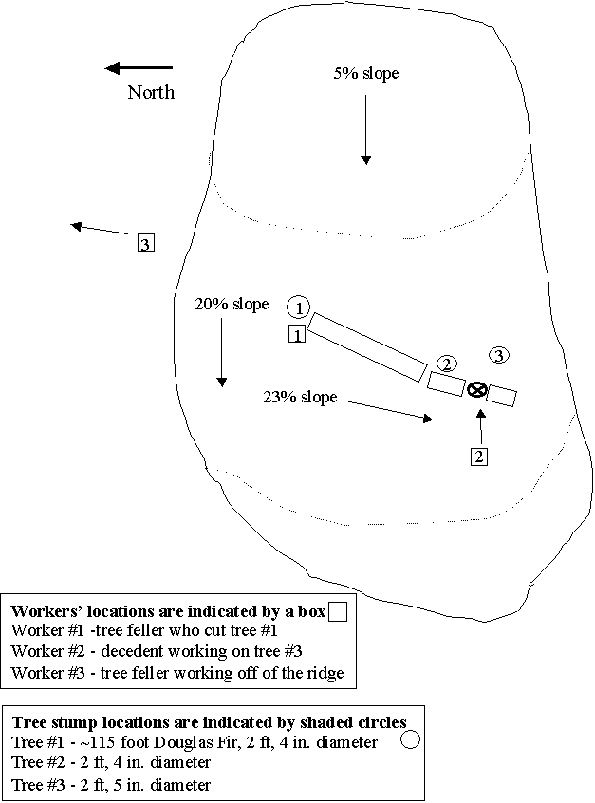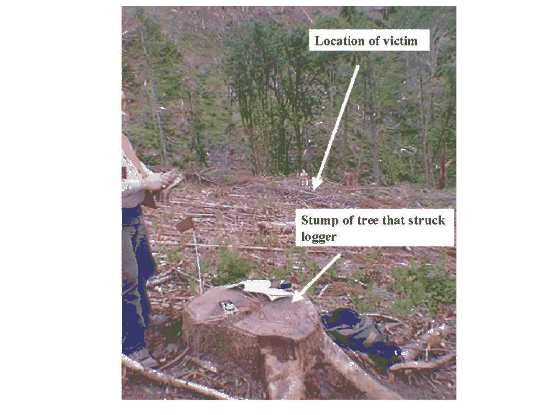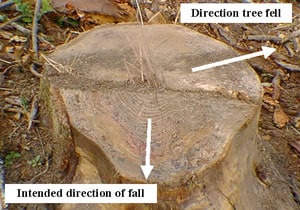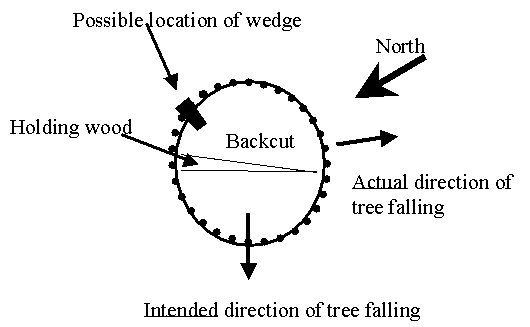Logger Killed when Struck by Top of Falling Tree, which was Felled by an Adjacent Cutter, in Washington State
 |
 |
Investigation: #98WA07601
Release Date: April 30, 1999
SUMMARY
On April 10, 1998, a 45 year old “tree faller” died after being struck by a twenty foot tree section that had broken from a tree felled by a co-worker. The victim was working a strip of the logging site down slope from two other cutters. A co-worker (another tree faller) cutting in the adjacent area, felled a tree measuring approximately 115-125 feet in height. As the felled tree descended to the ground, it struck one or more standing trees and broke into several sections. The top section of the felled tree struck the victim as he was trying to escape. The local emergency medical rescue unit was summoned via radio and responded to the incident scene, but the victim died from the injuries sustained in the incident.
To prevent future similar occurrences, the Washington Fatality Assessment & Control Evaluation (FACE) Investigative team concluded that loggers should follow these guidelines:
- All tree cutting operations should adhere to the principle that a distance of at least two tree lengths should separate adjacent occupied work areas.
- A “pre-job safety plan” should be in place for the cutting site and the plan should be reviewed prior to each days’ cutting.
- Training and education in logging operations should be a continuing process for skills development and for the understanding of safe methods and practices in the logging industry.
- A timely warning should be given prior to felling each tree.
- The felling of a cut tree should be controlled by a proper under-cut and back-cut, leaving hinge wood of sufficient thickness to guide the tree during it’s fall.
- A well-defined escape path should be planned so a quick retreat can be made to a safe area “out of harms way” from a falling tree.
- The area surrounding partially-cut trees which are still standing, should be clearly identified (or marked if possible) to warn all persons of the potential for those trees to fall in an uncontrolled manner.
INTRODUCTION
On April 13, 1998, the Washington FACE Program was notified by CFOI * (Census of Fatal Injuries) of the death of a 45 year old logger on April 10th.
The Washington FACE Principal Investigator and the Field Investigator met with the regional WISHA ** (Washington Industrial Safety & Health Administration) representative who was investigating the case. After reviewing the case with WISHA, the WA FACE team traveled with the WISHA representative to the incident site. The WISHA representative helped pinpoint the incident location, logging site detail, and defined the position of the loggers involved in this incident.
The logging site was on private forest land owned by a forest products company. The company contracts with local logging firms to harvest their forest lands on a regular basis. Trees are harvested according to a schedule defined in a forest management plan developed by the landowner. The practice of contracting logging operations has become more common in the U.S., as the large forest products companies are streamlining and down sizing due to the economies of the business.
This incident involved a contract with a local logging contractor who had been in the logging business for many years and had performed logging for this landowner and other land owners throughout the region.
The victim in this fatality was a 45 year old male “logger”. The deceased, at the time of the incident, was working as a tree faller in conjunction with two other tree fallers. The victim’s co-workers will be noted in the body of this report, as “tree faller #1” and “tree faller #3”. The victim will be noted as “tree faller #2”. The team had been contracted to log (cut) a stand of trees located on private forest land. The team had been working this logging site for 30 days prior to the fatality.
It is unclear whether the deceased was an employee working for the logging contractor or whether he was a self-employed/independent contractor. It is clear however, that the logging contractor directly employed tree fallers #1 and #3.
The deceased had been in the logging profession for over 22 years and had considerable experience performing the varied types of jobs within the logging industry. Tree faller #3 (the victim’s brother) also had over 20 years of experience, while tree faller #1 had the least amount of experience with only about 1.5 years in the logging business. Tree faller #1 was also a newcomer to the state.
INVESTIGATION
On April 10, 1998, a Friday morning, the victim went to work at the current logging site. This particular logging team consisted of three persons, including the victim. They started work at approximately 7:00 AM, their usual starting time.
The stand of trees was situated on a moderate slope, averaging about 20-25 degrees. The stand of trees sloped from the east at it’s highest point, to the west and south at it’s lowest point. The logging team was cutting and advancing along the slope, in a northwesterly direction (see figures 1 and 2).
The weather was clear and dry; there were no adverse environmental conditions, such as rain or fog or similar issues to complicate the days’ logging activities.
In establishing their work areas for that particular day, one of the more experienced cutters (tree faller #3) was situated up slope, working the northeast section of the tree stand. The least experienced logger (tree faller #1), who cut the tree resulting in the fatality, was working the middle of the slope, and the victim was working the lower side of the slope.
At approximately 10:55 AM, the cutter (tree faller #1) working the middle of the slope, had just completed a cut on a Douglas Fir, estimated to be about 115-125 feet tall. Instead of falling in a northwesterly direction as intended, the tree fell in a south/southwesterly direction, toward the location of the lower positioned tree faller #2 (the victim) (see figure 3).
As it fell, the tree struck one or two other standing trees. Several sections of the top of the felled tree broke off and fell to the ground.
When the victim became aware that the felled tree was falling in his direction, he tried to escape.
One of the broken top sections (about 20 feet long, with a diameter of about 12 inches at its thickest point) struck the victim before he was able to escape the danger area. The victim was approximately 110 feet from the stump of the incident-causing tree.
It is unclear whether any warning signal was given. WISHA’s interview with the cutters indicated that no warning was sounded when the tree was ready to fall.
The local emergency squad was called via radio to respond to the incident. A helicopter rescue unit was summoned due to the remoteness and difficulty in reaching the scene. The response time was roughly about 25 – 30 minutes. A land-based rescue unit also responded and it took them approximately 1.5 hours to get to the perimeter of the incident site. The victim died at the scene.
CAUSE OF DEATH
The medical examiner listed the cause of death as a laceration of the aorta and multiple skeletal fractures due to blunt impact to the head and trunk.
RECOMMENDATIONS/DISCUSSION
Recommendation #1: All tree cutting operations should adhere to the principle that a distance of at least two tree lengths should separate adjacent occupied work areas.
Discussion: The investigation of this fatality showed that the victim and the cutter who felled the tree, were working too close. It was estimated that the felled tree was 115-125 feet in height. The distance from tree faller #1 to the victim was 110 feet.
There are many factors involved in conducting a safe timber cutting operation, but one basic element that perhaps transcends all others is the principle of not being in “the line of fire”. This principle is primarily a concept that defines the position of the individual in relation to the hazard exposure or potential exposure. This is a basic principle in Job Safety Analysis (JSA), System Safety Reviews, and Risk Management Assessment.
In this particular fatality, the two loggers involved did not follow this exposure principle which is one of the basic rules of timber cutting. The distance between the logger who felled the “fatal” tree and the victim, was well within the height of the tree. Even though the intended “fall” direction of the tree was 90 degrees away from the logger working down slope of the tree stand, trees do not always fall in the intended direction.
It is clear from this investigation that this fatality would not have happened if the work areas were at least twice the distance of the height of the tree being felled from the adjacent work areas.
In this instance, a “greater than twice the distance” might have been applicable because the fatally-injured logger was working down slope on the stand of trees. A tree faller should not work directly below another tree faller because “gravity” impacts the safe distance ratio between the cutters and their work areas.
Knowing the tree species and the diameter of the tree, an experienced tree faller can estimate the relative height of the tree. The tree faller then can set up a safe work area/work zone in conjunction with the other tree fallers in the area. For information related to tree species and measurements, tree fallers can contact area foresters, forest services and forestry organizations.
Tree heights can also be calculated / measured using “percent scale clinometers”, both on level ground and sloping ground, and also by the use of “altimeters”. This equipment is available from most forest supply distributors.
The majority of severe logging injury incidents occur due to sliding, rolling or falling timber during felling, skidding and loading. The times when incidents are most likely to occur are when a tree is toppled or when hanging trees are pulled down.2
Fatal incidents during logging work are usually caused by falling trees or branches, or by moving logs.2
It is extremely important that good communication takes place between tree fallers working any tree stand. The falling teams need to know exactly where their fellow cutters are located at all times. Workers have to recognize when they are working too close. On some occasions when the cutting strip narrows or when working near draws/creeks and ravines, the tree fallers would need to redefine the cutting corridors until they can achieve the needed separation. The two tree length or more separation between fallers has to be constant however, and maintained at all times.
Recommendation #2: A “pre-job safety plan” should be in place for the cutting site and the plan should be reviewed prior to each days’ cutting.
Discussion: Prior to a logging operation at a new site, a pre-job safety plan should be developed that defines how the site should be safely logged. In addition, prior to each days’ logging, the loggers should conduct a brief review of the plan and reconfirm each loggers’ work area and the direction of the logging.
A factor in this particular incident was that it was unclear who was in the position of leadership or who was supervising this logging site. A site action plan and a daily briefing needs to occur in order to safely and effectively coordinate the logging activities. Some procedure should be in place that communicates needed information to the logging team. It is important that the pre-job safety plan be clearly understood, that the work areas are well defined and hazards and other potential emergency situations are addressed. This should include having evacuation routes planned in the event that a wayward falling tree inadvertently drops into the loggers’ work space.
A “pre-job safety plan” is an important logger’s tool, but the work layout, (i.e. opening the strip) is a process that is in constant motion during the days’ activity. In order to support the safety plan, the tree fallers must be in continual communication with each other during the cutting process.
Recommendation #3: Training and education in logging operations should be a continuing process for skills development and for the understanding of safe methods and practices in the logging industry.
Discussion: Experience is a wonderful teacher and a necessary element in skills development, but unguided experience can foster poor technique and enhance bad habits. Training and education are necessary compliments to what we learn via the experience route. In this incident we had two very experienced and most likely, two very qualified loggers working with a considerably less experienced logger.
All individuals who work in high hazard industries like logging should be involved in continuing training and education processes. These processes not only introduce new innovation and new techniques in logging operations but also reinforce best practices and provide for review of current safety and regulatory requirements for the industry.
A continuous training and education process, coupled with on the job experience, are foundation blocks that enable workers to make good judgments.
Other issues involved with the elements of training, education and experience in this case include: the fatal tree did not fall in the intended direction; no warning was given prior to the tree falling; the work areas where within the height radius of the trees being cut instead of at least twice the distance; and the victim’s escape route was not well-planned.
Recommendation #4: A warning must be given in a timely manner prior to felling each tree.
Discussion: A basic safety procedure in timber cutting is to provide a timely and adequate warning just prior to the felling of a tree. No warning was given in this instance when the fatal tree fell.
It is also a responsibility of those persons working in the adjacent areas to respond to the warning by indicating that they had heard, are in the clear, and it is safe to proceed with the final cut.
Again, as in the previous recommendations, communication between the tree fallers is a vital part of good logging practice.
Recommendation #5: The felling of the cut tree should be controlled by a proper under-cut and back-cut, leaving hinge wood of sufficient strength to guide the tree during it’s fall.
Discussion: In examining the stump of the felled tree (see figure 3) it was found that the tree fell approximately 90 degrees from the intended direction, toward the victim working on the lower slope. The WISHA representative (who has direct logging experience) determined that the under-cut and back-cut were poorly done and there was an attempt to cut a dutchman ***. A dutchman is a cut to counteract the natural lean of the tree and help maneuver the fall of a tree in the desired direction.3, 4 There was also insufficient hinge wood (or holding wood) thickness, which would have helped control the direction of the tree’s fall.
The investigation also indicates that a wedge was used in an attempt to direct the fall of the tree. However the impression the wedge made on the stump of the tree, suggests that it may have helped the tree fall in the wrong direction. The wedge was slightly off-center and positioned on the up-slope side of the tree which would have helped the tree to fall in the down-slope direction.
Undercuts and backcuts are one of the principal cutting techniques to safely control the tree throughout the felling process. The undercuts and backcuts must be made at a sufficient height above ground level to enable the cutter to safely begin the cut and to allow for quick escape from the falling tree. As part of the cut, care should be taken to leave enough wood (hinge wood or holding wood) to guide the tree and prevent it from slipping or twisting from the stump and allowing the tree to fall in an unintended direction.3, 4, 5
Recommendation #6: A well-defined escape path should be planned so a quick retreat can be made to a safe area “out of harms way” from a falling tree.
Discussion: Many factors affected this fatality. Clearly, the distance between work zones was a major factor, but another factor was the escape route used by the victim.
The victim was already working within the hazard zone because of the proximity to his fellow logger and the height of the trees that were being cut. The deceased also was working down slope of his fellow logger, which would potentially increase the hazard.
An escape plan is primarily designed for the logger felling the tree. The escape path is to be used at the point when the tree is ready to fall.
In this case, the victim should have been aware that a tree being cut by his fellow logger working up-slope, could fall in his direction. He should have been prepared to take evasive action by choosing a path that would take him away from a possible track of an errant falling tree. When the incident tree fell, the victim took an escape path that coincided with the path of the top section of the tree that fell. (A factor in the choice of escape route could have been the fact that there was no warning given prior to, or during the fall of the tree.) The escape path chosen by the victim could have been just a reactionary route, rather than a pre-defined escape path.
Recommendation #7: The area surrounding partially-cut trees which are still standing, should be clearly identified (or marked if possible) to warn all persons of the potential for those trees to fall in an uncontrolled manner.
Discussion: An issue that arose around this fatality was the fact that the victim in this incident was in the process of felling a tree when the fatal incident occurred. The partially-cut tree, in turn, presented a hazard to all persons with a need to travel or work in the area subsequent to the incident. This would include other loggers responding to the incident, the rescue team, other persons assisting in the rescue, persons conducting an investigation of the incident and then to the loggers who would eventually finish cutting the stand of trees.
It is important that persons be aware of the possible danger posed when a partially-cut tree is left standing. The hazard from the partially cut tree needs to be identified (and marked if possible) by the loggers who where working the tree stand and then appropriate precautions need to be taken by those with a need to enter the hazard area such as the rescue team attending to the injured worker.
The rescue team and those assisting in forest operations rescue should be educated in the hazards that they might face in an active timber harvest site. Logging associations and logging companies could work with rescue teams to develop a basic protocol for forest rescue.
The felling of the partially-cut trees should be felled by the logging operation as soon as it is determined safe to do so.
SUMMARY
In summary, the logging industry continues to be one of the high hazard industries for serious injury and death. NIOSH (the National Institute for Occupational Safety & Health) states that the logging industry’s average annual fatality rate is more than 23 times that of all U.S. workers.6 Stringent safe work practices must be applied if these numbers are to improve and incidents of the type discussed in this investigation are to be prevented.
References
- Raphael, Ray, More Tree Talk : the people and politics of timber, Covelo Calif. : Island Press, c1984.
- Langley, Ricky L. [et al.] editors, Safety and Health in Agriculture, Forestry, and Fisheries, Rockville, Maryland : Government Institutes, c1997.
- Safety Standards for Logging Operations, Chapter 296-54 WAC, State of Washington, Department of Labor and Industries.
- Yarding & Loading Handbook, Dept. of Insurance & Finance, OR-OSHA Standards & Technical Resources Section.
- Code of Federal Regulations, Labor 29 CFR 1910 Subpart R: Special Industries/ 1910.266- Logging operations, U.S. Department of Labor.
- NIOSH Alert: Request for Assistance in Preventing Injuries and Deaths of Loggers, DHHS (NIOSH) 95-101.
ILLUSTRATIONS

Figure 1. Schematic of the scene of the incident.

Figure 2. Photograph of the scene of the incident.


Figure 3. Photograph and schematic of stump of the tree that struck the logger.
Appendix
Other Safety Suggestions:
As part of the Washington State FACE Investigation process, we research different ideas and safety applications that currently are not used by the industry in their operations. Two of those suggestions are outlined in this appendix.
- Safety Monitor: Establish a person to act as a safety monitor similar to what is used in the construction industry. The safety monitor would help observe the job site to ensure the safe positioning of all persons working in the area and also prevent persons from entering into danger areas. A hand-held radio communication system could be used to complement the safety monitor process.
- An Electronic Proximity Device: Develop and use a proximity sensing device that can be used by loggers while working at logging sites. The proximity device would be a belt-carried unit about the size of a hand-held radio or pager. The device theoretically could be set up to sound a warning signal to the wearer when entering into another logger’s work zone. The device could be programmable so that different size work zone areas could be accommodated.
Acknowledgments
In conducting this Logging Fatality Investigation, the Washington State FACE Investigation Program requested that the contents of this report be reviewed by key representatives from the logging/forest products industry, private consultants and Washington State and Federal agencies, prior to its’ publication.
Though we are not able to acknowledge specific individuals for their invaluable input into this document, we would like to recognize the following for their help and support to the FACE process:
- The employer where the incident took place
- WISHA enforcement
- WISHA Policy & Technical Services staff
- A private consultant (a former logger)
- Federal FACE Program Management (NIOSH)
- Washington Contract Loggers Association
In reviewing the WISHA standards, there are defined requirements that deal with logging, cutting and falling trees. The applicable standards specifically state:
Work areas shall be assigned so that a tree cannot fall into an adjacent occupied work area. The distance between work areas shall be at least twice the height of the tree being felled. A greater distance may be required on downhill slopes depending on the degree of the slope and on the type of trees and other considerations. WAC 296-54-529(28)
Trees shall not be felled if the falling tree can endanger any worker or strike any line or any unit in the operation. WAC 296-54-529(8)
Cutters shall not be placed on a hillside immediately below other operations where there is possible danger. WAC 296-54-529(33)
This document may be copied and distributed as needed. More information about the FACE program can be found on our World-Wide Web site at “http://www.lni.wa.gov/external icon” (Link updated 6/15/2006) or by calling us toll-free at 1-888-667-4277.
* CFOI is a BLS (Bureau of Labor Statistics) cooperative federal /state system to collect information on all fatal occupational injuries of public and private sector workers.
** The OSHA State Plan program in Washington State.
*** Dutchmans are “A method of falling timber consisting of inserting a piece of material into one side of the undercut to assist in pulling a tree against the lean, or section of the undercut can be left in a corner to accomplish the same purpose.”3
To contact Washington State FACE program personnel regarding State-based FACE reports, please use information listed on the Contact Sheet on the NIOSH FACE web site Please contact In-house FACE program personnel regarding In-house FACE reports and to gain assistance when State-FACE program personnel cannot be reached.
Back to Washington FACE reports
Back to NIOSH FACE Web
